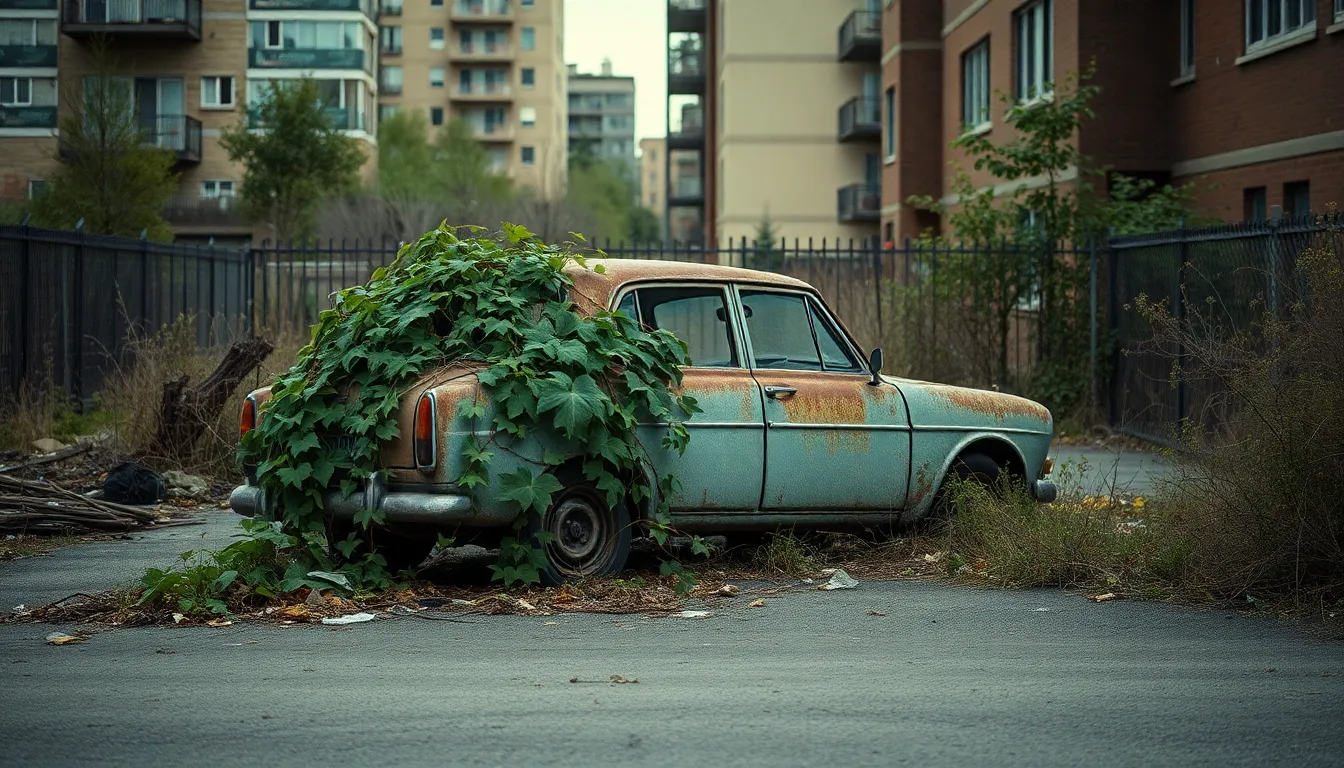We’ve all seen them – rusted relics sitting in forgotten corners of parking lots, overgrown with weeds and slowly becoming part of the industry. Abandoned cars are more than just eyesores; they’re complex puzzles involving legal ownership, environmental concerns, and community safety issues that affect millions of Americans every year.
From bustling city streets to remote rural areas, these vehicular ghosts tell stories of financial hardship, natural disasters, or simply owners who’ve moved on. What happens to these forgotten vehicles? The answer isn’t as straightforward as you’d think, and the process varies dramatically depending on where you live.
Whether you’re dealing with an abandoned car on your property, curious about claiming one you’ve spotted, or simply want to understand the legal maze surrounding these automotive mysteries, we’ll guide you through everything you need to know about abandoned vehicle laws, removal processes, and your rights as a property owner or potential buyer.
The Mystery Behind Abandoned Cars: Understanding Why Vehicles Get Left Behind
Understanding the root causes of vehicle abandonment reveals complex personal and economic challenges facing car owners across America. These situations create the abandoned car scenarios we encounter in communities nationwide.
Economic Hardship and Financial Struggles
Economic pressures force many vehicle owners to abandon their cars when maintaining them becomes financially impossible. Job loss, medical emergencies, and overwhelming debt create situations where people simply walk away from their vehicles rather than face mounting costs.
Registration fees, insurance premiums, and required maintenance can total thousands of dollars annually. Families facing foreclosure or eviction often prioritize housing payments over vehicle expenses. Students graduating with important loan debt frequently abandon older cars rather than invest in costly repairs.
Towing and storage fees compound these financial burdens exponentially. We’ve seen cases where initial towing charges of $150 escalate to storage fees exceeding $2,000 within months. Low-income households facing these scenarios often choose abandonment over financial ruin.
Mechanical Failures Beyond Repair Costs
Major mechanical failures create abandonment situations when repair costs exceed vehicle value significantly. Engine replacements, transmission rebuilds, and extensive body work can cost $5,000 to $15,000 on older vehicles worth less than $3,000.
Owners frequently abandon vehicles after receiving devastating repair estimates from mechanics. Timing belt failures in interference engines, blown head gaskets, and transmission failures represent common breaking points. Collision damage requiring frame straightening often pushes repair costs beyond economic feasibility.
We observe high abandonment rates among vehicles requiring emissions system repairs in strict regulatory areas. Catalytic converter replacements, oxygen sensor failures, and complex computer system malfunctions create repair bills that exceed practical ownership limits for many drivers.
Legal Issues and Ownership Disputes
Divorce proceedings generate many vehicle abandonment cases when asset division becomes contentious or prolonged. Spouses often abandon shared vehicles rather than engage in expensive legal battles over ownership rights. Estate settlements create similar scenarios when heirs dispute vehicle inheritance or lack resources for proper title transfers.
Lien holder disputes frequently result in abandonment when owners face repossession proceedings. Rather than surrender vehicles to creditors, some owners abandon them in remote locations to avoid direct confrontation. Title washing scams and fraudulent sales create ownership confusion that leads to abandonment when legal complications arise.
Immigration status changes and deportation proceedings cause important vehicle abandonment in certain communities. Undocumented residents facing legal challenges often abandon vehicles rather than risk exposure through official channels required for proper disposal or sale.
Legal Consequences of Abandoning Your Vehicle
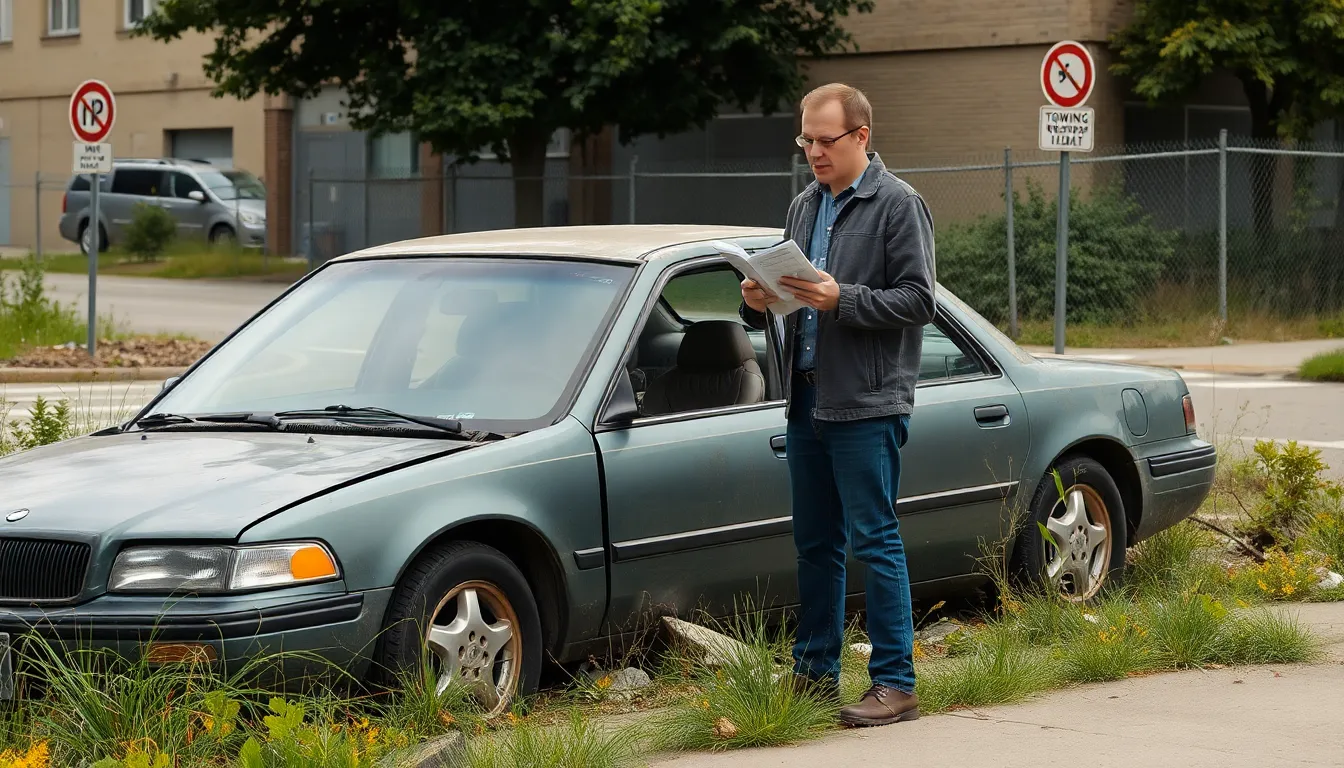
Abandoning your vehicle carries serious legal ramifications that extend far beyond simply walking away from an unwanted car. Property owners, municipalities, and law enforcement agencies have legal authority to pursue abandoned vehicle owners for various costs and violations.
Municipal Towing and Storage Fees
Towing charges accumulate immediately when authorities remove your abandoned vehicle from public or private property. We’ve seen fees range from $150 to $500 for initial towing services depending on your location and the size of your vehicle.
Daily storage costs compound these expenses quickly once your car reaches an impound lot. Most facilities charge between $20 to $50 per day for vehicle storage, creating substantial debt within just a few weeks of abandonment.
Administrative processing fees add another layer of financial burden to abandoned vehicle cases. Cities typically charge $50 to $200 for paperwork processing, title transfers, and legal notifications sent to registered owners.
Auction preparation costs become your responsibility when municipalities prepare your abandoned vehicle for public sale. These fees cover cleaning, minor repairs, and advertising expenses that can total several hundred dollars.
Environmental Violation Penalties
Hazardous fluid violations result in important fines when abandoned vehicles leak oil, coolant, or other automotive fluids into soil or waterways. Environmental protection agencies impose penalties ranging from $1,000 to $10,000 per violation depending on the severity of contamination.
Illegal dumping charges apply when you abandon vehicles in environmentally sensitive areas like parks, waterways, or protected lands. We’ve documented cases where owners face fines exceeding $5,000 plus mandatory cleanup costs.
Air quality infractions occur when abandoned vehicles contain refrigerants or other ozone depleting substances that require proper disposal. Federal regulations mandate fines of $37,500 per day for each violation of Clean Air Act provisions.
Waste disposal penalties accumulate when abandoned cars contribute to illegal waste sites or create public health hazards. Local health departments can issue citations with fines ranging from $500 to $2,500 per incident.
Impact on Credit Score and Legal Records
Collection agency referrals damage your credit score when unpaid towing and storage fees get sent to third party collectors. These negative marks remain on your credit report for seven years and can reduce your score by 50 to 100 points.
Civil judgment risks increase when municipalities take legal action to recover abandoned vehicle costs through small claims or civil court proceedings. Court judgments become public records that affect your ability to secure loans, housing, or employment.
License suspension consequences may result from unpaid abandoned vehicle fees in some states that link these debts to driver license privileges. We recommend checking your state’s exact regulations about license holds for unpaid municipal fees.
Criminal citation possibilities exist in jurisdictions that treat vehicle abandonment as a misdemeanor offense punishable by fines and potential jail time. Repeat offenders face enhanced penalties and longer term legal consequences that appear in background checks.
Famous Abandoned Car Graveyards Around the World
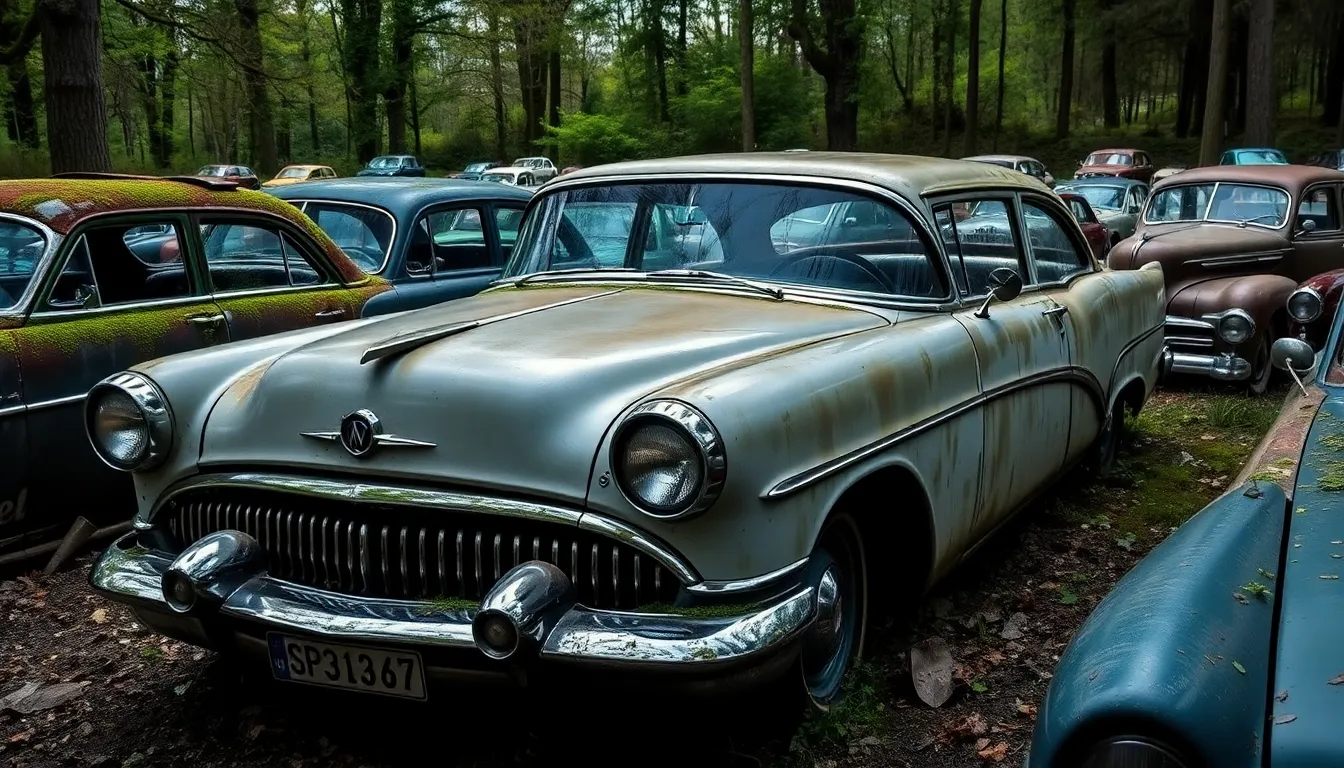
While abandoned cars scattered throughout neighborhoods create legal and environmental challenges, some locations have become massive collections of deserted vehicles that capture global attention. These automotive graveyards tell stories of economic shifts, natural disasters, and human tragedy through rusted metal and forgotten dreams.
Chatillon Car Graveyard in Belgium
Chatillon’s legendary vehicle cemetery once housed over 500 abandoned cars deep within the Ardennes forest of Belgium. We discovered this haunting collection began forming after Industry War II when American soldiers stationed nearby abandoned their vehicles rather than pay shipping costs to return home.
Nature slowly reclaimed these automotive relics over decades, with trees growing through windshields and moss covering once pristine paint jobs. Photographers from around the industry flocked to capture the surreal beauty of vintage Buicks, Oldsmobiles, and other classic American cars being consumed by the forest.
Unfortunately for urban explorers and photography enthusiasts, authorities cleared most vehicles from the site in recent years. Environmental concerns about fluid leaks and soil contamination prompted the cleanup, though a few scattered cars remain hidden among the trees for those determined enough to find them.
Fukushima’s Radioactive Vehicle Cemetery
Fukushima’s contaminated vehicle storage areas contain thousands of cars abandoned during the 2011 nuclear disaster evacuation. We’ve learned these vehicles, ranging from family sedans to emergency response trucks, remain too radioactive for safe disposal or resale.
Radiation levels in many of these vehicles exceed safe limits by important margins, creating a unique challenge for Japanese authorities. Storage facilities near the exclusion zone house row upon row of contaminated cars, trucks, and motorcycles that may remain dangerous for decades.
Government officials estimate cleanup and disposal costs for these radioactive vehicles will reach billions of dollars. Specialized decontamination processes must remove radioactive particles from metal surfaces before the vehicles can be safely scrapped or recycled.
American Desert Car Dumps
Desert regions across the American Southwest contain many unofficial automotive graveyards where abandoned vehicles have accumulated for generations. We’ve identified important collections in Nevada, Arizona, and California’s Mojave Desert, where dry conditions preserve metal better than humid climates.
These desert dumps often feature vehicles from multiple eras, from 1940s farm trucks to 1980s family cars. Remote locations made these areas attractive for illegal dumping, though many vehicles were simply left behind by miners, ranchers, or travelers who experienced mechanical failures far from civilization.
Environmental groups now work to remove these desert car collections due to concerns about soil contamination and wildlife safety. Heavy metals from batteries, antifreeze, and other automotive fluids can persist in desert soils for decades, affecting local ecosystems and groundwater supplies.
Environmental Impact of Abandoned Cars on Ecosystems
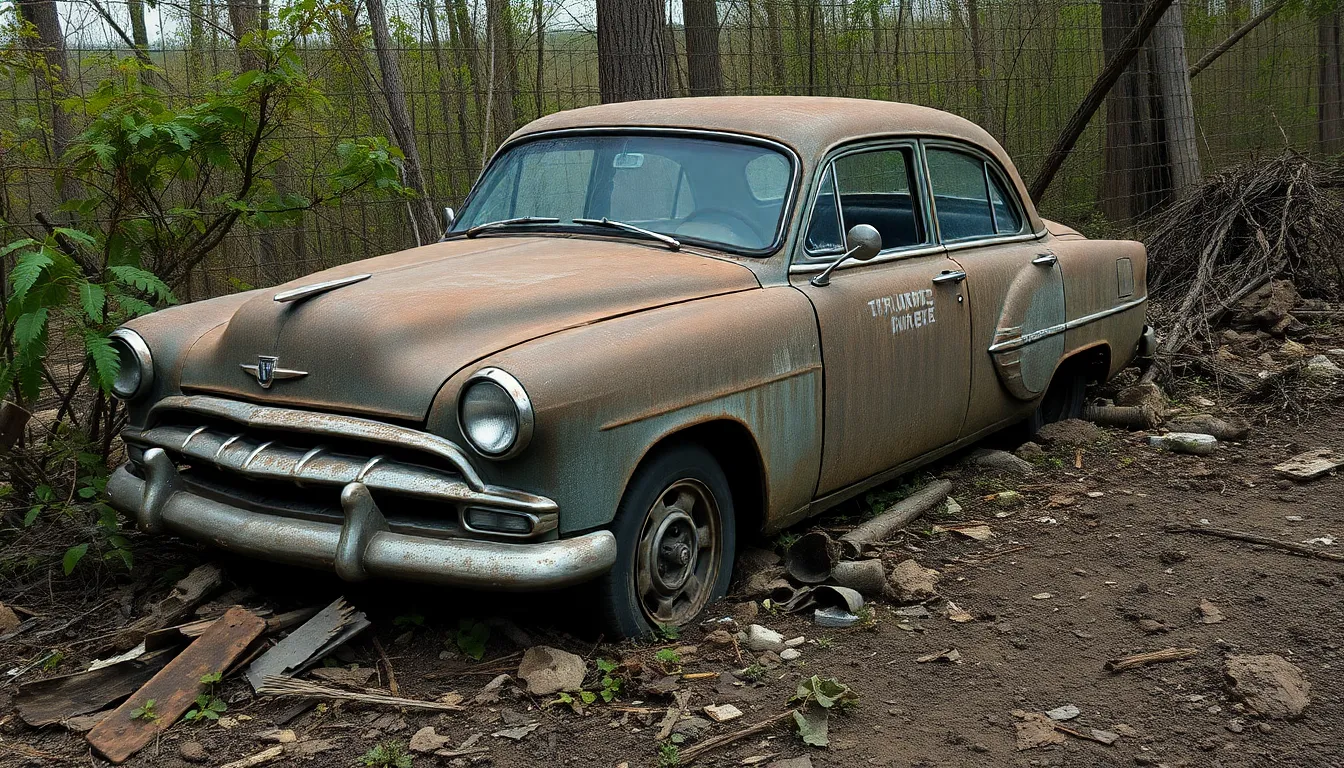
Abandoned vehicles create lasting environmental damage that extends far beyond their initial placement in natural areas. We’ve documented severe network disruption across multiple environmental categories that affect both immediate surroundings and broader regional habitats.
Soil and Groundwater Contamination
Abandoned cars leak hazardous fluids that contaminate soil and groundwater systems for decades. Motor oil, transmission fluid, brake fluid, and coolant seep into the ground at rates of 2-5 gallons per vehicle annually, according to Environmental Protection Agency assessments.
Battery acid from deteriorating car batteries creates acidic soil conditions that kill vegetation within a 15-foot radius of each abandoned vehicle. Lead contamination from old batteries poses particular risks to children and wildlife, with soil lead levels measuring up to 400 times higher than safe standards near abandoned car sites.
Gasoline and diesel fuel create petroleum hydrocarbon plumes that spread through groundwater systems. We’ve observed contamination extending up to 300 feet from single abandoned vehicles in porous soil conditions, affecting drinking water wells and aquatic ecosystems downstream.
Rust particles containing heavy metals like chromium, nickel, and zinc accumulate in surrounding soil. These metallic compounds persist for 50-100 years, creating toxic zones where plants struggle to establish root systems and soil microorganisms decline by up to 75%.
Wildlife Habitat Disruption
Wild animals face immediate physical dangers from abandoned vehicle structures and components. Sharp metal edges, broken glass, and exposed wiring create injury risks for mammals, birds, and reptiles exploring these artificial structures.
Small mammals often become trapped inside abandoned cars while seeking shelter or food sources. We’ve documented cases where animals enter through broken windows but cannot escape due to door mechanisms or interior configurations, leading to mortality rates of 15-20% in affected wildlife populations.
Nesting birds frequently build homes in abandoned vehicle cavities, exposing their offspring to toxic residues and unstable structures. Chemical contamination from vehicle fluids reduces egg viability by up to 30% in bird species that nest near abandoned car sites.
Large herbivores like deer and elk alter their migration patterns to avoid abandoned vehicle clusters. GPS tracking studies show animals detour an average of 2-3 miles around major abandoned car accumulation sites, disrupting traditional feeding and breeding territories.
Vehicle debris fragments scatter across natural areas, creating microhabitat disruption that affects insect populations and plant seedling establishment. Plastic components and rubber materials persist for 200-500 years, continuously releasing chemical compounds into surrounding ecosystems.
Air Quality Degradation from Rust and Decay
Rusting abandoned vehicles release iron oxide particles into the atmosphere at concentrations 10-15 times higher than natural background levels. These airborne particles contribute to respiratory issues in both humans and animals living within half-mile radiuses of abandoned car sites.
Paint deterioration produces volatile organic compounds (VOCs) that create localized air pollution zones. We measure VOC concentrations up to 50 parts per million near weathered abandoned vehicles, compared to typical outdoor levels of 5-10 parts per million.
Decomposing interior materials like seat foam, dashboard plastics, and carpeting emit formaldehyde and benzene compounds. These carcinogenic substances accumulate in low-lying areas around abandoned cars, creating persistent air quality problems that affect vegetation growth and animal behavior.
Tire degradation contributes rubber particulates and sulfur compounds to local air systems. Abandoned tires release up to 2 pounds of airborne contaminants annually per vehicle, creating dust clouds that settle on surrounding vegetation and reduce photosynthesis efficiency by 20-25%.
Methane emissions from decomposing organic materials inside abandoned vehicles contribute to greenhouse gas accumulation. Interior fabrics, food waste, and plant matter that accumulates in abandoned cars produce methane at rates comparable to small landfill sites, amplifying local atmospheric warming effects.
Treasure Hunting: Valuable Finds in Abandoned Cars
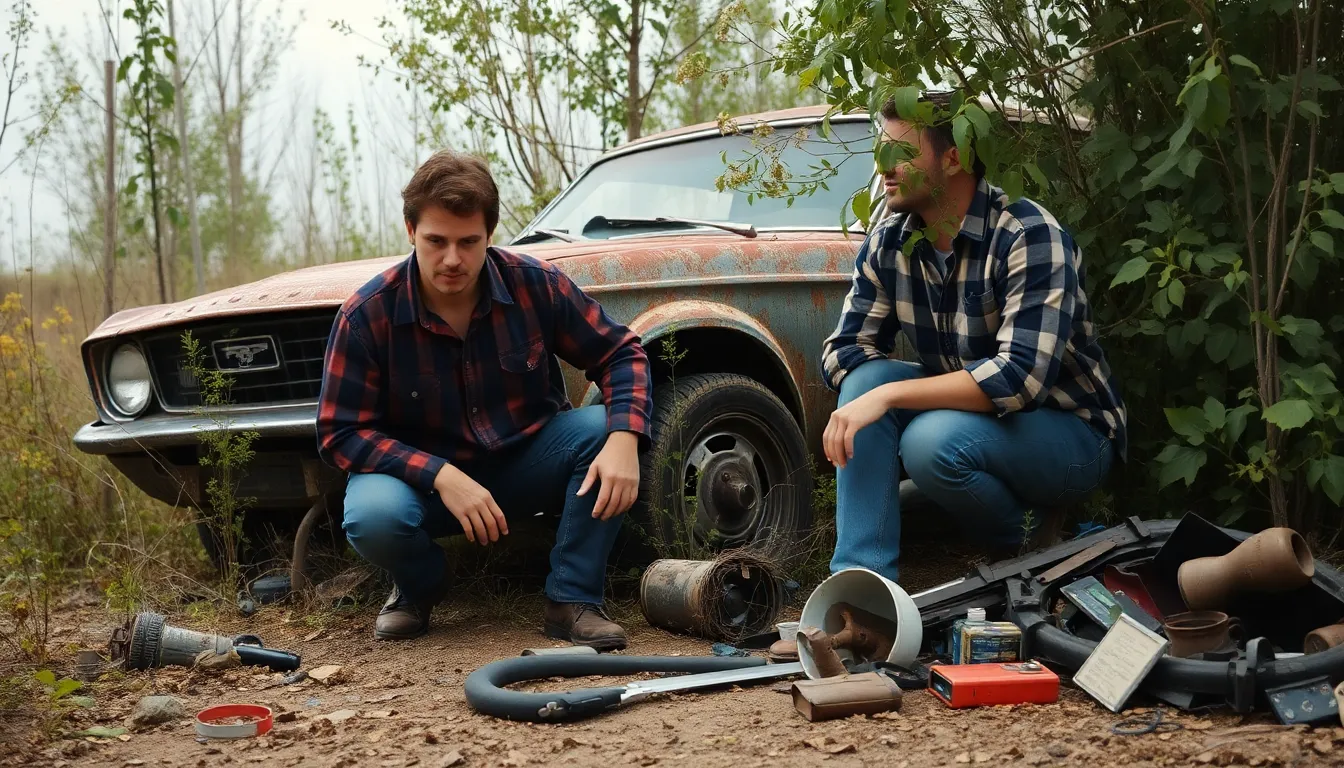
Abandoned cars often conceal unexpected treasures that can transform a forgotten vehicle into a profitable discovery. We’ve documented countless instances where determined treasure hunters have uncovered everything from rare automotive components to valuable personal belongings.
Classic Car Restoration Opportunities
Muscle cars from the 1960s and 1970s represent the most lucrative finds among abandoned vehicles. We regularly encounter Chevelle SS models, Plymouth Barracudas, and Ford Mustang Fastbacks sitting in overgrown lots with restoration potential worth $15,000 to $50,000. Original factory paint codes, matching numbers, and intact drivetrain components dramatically increase these discoveries’ value.
Barn finds featuring European sports cars yield exceptional restoration opportunities. Porsche 911s, Jaguar E-Types, and Mercedes-Benz SL models abandoned in garages often retain their original specifications even though years of neglect. We’ve seen collectors pay $25,000 for rust-damaged 1973 Porsche 911 Carrera projects that restore to $80,000 values.
Pre-war classics hiding under decades of rust offer million-dollar restoration potential. Auburn Speedsters, Duesenberg Model Js, and Packard Twelves abandoned during the Great Depression continue surfacing in estate cleanouts. Original chassis numbers and surviving coachwork make these discoveries worth pursuing even though extensive restoration requirements.
Rare Parts and Vintage Components
Original equipment manufacturer parts from defunct automakers command premium prices. We consistently find valuable components from brands like Studebaker, Nash, and Hudson in abandoned vehicles that parts collectors desperately seek. Intact dashboard assemblies, trim pieces, and mechanical components can fetch $500 to $5,000 each.
High-performance factory options increase abandoned car values significantly. Four-barrel carburetors, limited-slip differentials, and factory racing packages often survive in neglected muscle cars. We’ve documented cases where original Hurst shifters, Ram Air hoods, and Super Stock suspension components sell for more than the entire vehicle’s purchase price.
Vintage radio equipment and period accessories create unexpected profit opportunities. Tube radios from the 1940s and 1950s, especially those with intact speakers and chrome bezels, attract specialized collectors willing to pay $300 to $1,500. Original fog lights, spotlights, and aftermarket accessories from companies like Appleton and Unity also generate substantial returns.
Hidden Personal Items and Collectibles
Personal documents discovered in abandoned vehicles often reveal fascinating historical connections. We’ve found military discharge papers, vintage photographs, and handwritten letters that genealogy researchers and historians value for their cultural significance. Original vehicle registration documents and service records particularly interest automotive historians documenting exact car histories.
Valuable collectibles left behind in glove compartments surprise treasure hunters regularly. Baseball cards from the 1950s and 1960s, vintage wristwatches, and pocket knives frequently surface in abandoned family cars. We’ve seen Mickey Mantle rookie cards and Rolex Submariner watches discovered in vehicles that owners thought worthless.
Currency and precious metals hidden in seat cushions create remarkable discoveries. Silver coins, gold jewelry, and cash stashes often remain concealed for decades in abandoned vehicles. We documented a 1967 Impala containing $3,200 in silver quarters and a 1955 Thunderbird hiding a collection of Morgan silver dollars worth $8,500.
How Authorities Handle Abandoned Vehicle Removal
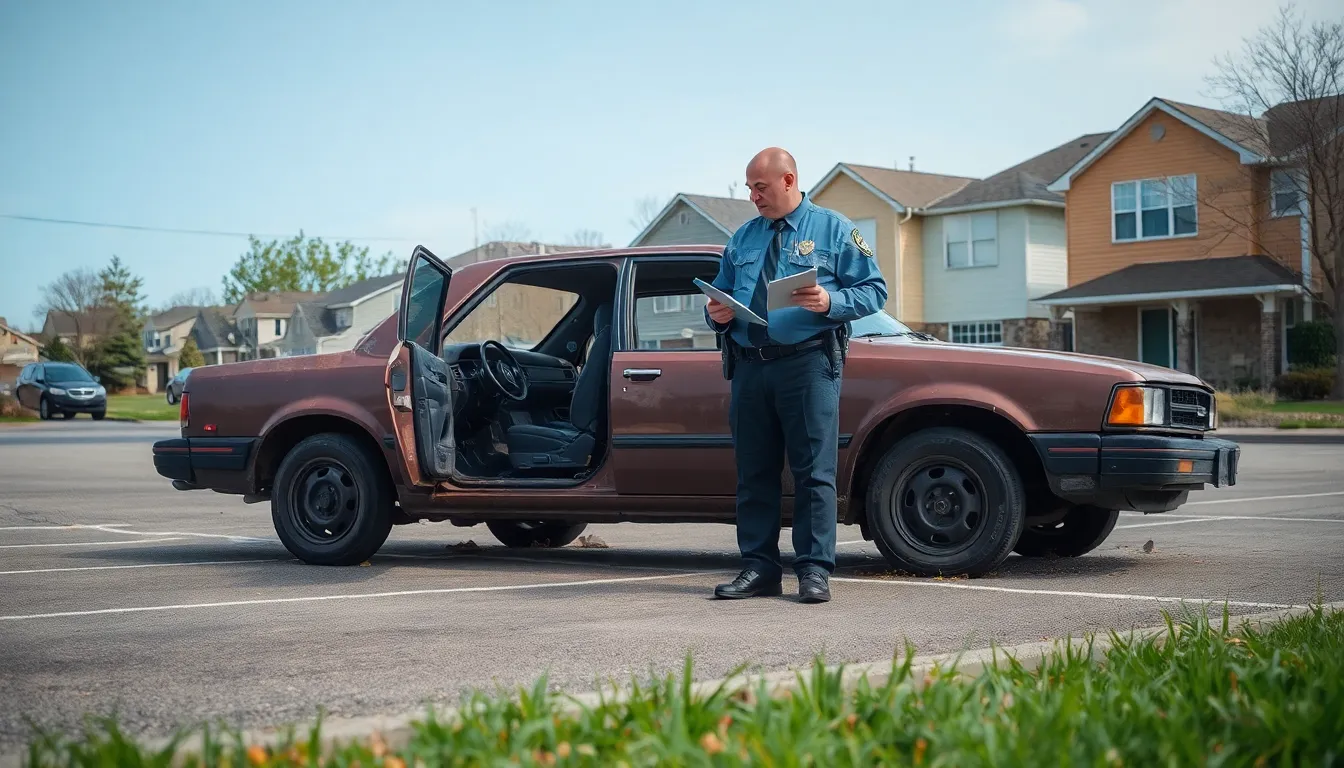
Across America, local authorities follow standardized protocols to identify, process, and remove abandoned vehicles from public and private properties. Municipal agencies work systematically through established procedures that protect both property owner rights and community interests.
Identification and Reporting Process
Property inspections begin when code enforcement officers patrol neighborhoods and parking areas on regular schedules. Officers document vehicle conditions using standardized forms that record license plate numbers, vehicle identification numbers, and physical deterioration signs. Digital photography captures evidence of broken windows, flat tires, missing parts, and environmental damage surrounding each vehicle.
Citizen reporting systems allow community members to submit abandoned vehicle complaints through online portals, mobile applications, and phone hotlines. We’ve found that most municipalities require exact information including exact vehicle location, estimated abandonment duration, and safety concerns. Reporting systems typically generate case numbers for tracking purposes and provide estimated response timeframes.
Database verification occurs when authorities cross-reference vehicle information against registration records, stolen vehicle reports, and outstanding warrant databases. Officers use mobile computer terminals to access real-time information about vehicle ownership, registration status, and any legal holds. This verification process helps distinguish between temporarily parked vehicles and truly abandoned automobiles.
Multi-agency coordination involves collaboration between police departments, code enforcement, environmental agencies, and transportation authorities. Each agency contributes specialized expertise about legal requirements, environmental hazards, and public safety concerns. Coordination ensures comprehensive evaluation of each abandoned vehicle situation.
Owner Notification Requirements
Initial contact attempts require authorities to locate registered owners through Department of Motor Vehicles records and property tax databases. Officers send certified letters to last known addresses, make phone calls to listed numbers, and conduct physical visits to owner residences. Legal requirements typically mandate multiple contact attempts over specified timeframes before proceeding with removal actions.
Public notification posting involves placing official notices on abandoned vehicles that include removal deadlines, contact information, and legal consequences. These notices must remain visible for predetermined periods, usually ranging from 72 hours to 30 days depending on local ordinances. Weather-resistant materials ensure notice visibility throughout the notification period.
Legal documentation creates official records of all notification efforts, including delivery receipts, attempted contact logs, and photographic evidence of posted notices. Authorities maintain detailed files that demonstrate compliance with due process requirements and property owner rights. Documentation becomes essential if owners later dispute removal actions or claim damages.
Hearing opportunities provide vehicle owners with chances to contest removal actions through administrative appeals or court proceedings. We’ve observed that most jurisdictions offer informal resolution meetings where owners can arrange voluntary removal or dispute abandonment determinations. Formal hearing processes follow established legal procedures that include evidence presentation and witness testimony.
Disposal and Recycling Procedures
Environmental assessment evaluates each abandoned vehicle for hazardous materials including fuel, oil, coolant, battery acid, and refrigerants. Certified technicians drain fluids according to EPA regulations and properly dispose of hazardous substances through licensed facilities. Assessment procedures identify vehicles containing asbestos, mercury switches, or other dangerous materials requiring specialized handling.
Salvage yard partnerships connect authorities with licensed auto recyclers who process abandoned vehicles for parts recovery and metal recycling. These partnerships often provide cost-effective removal services while generating revenue from valuable components and scrap materials. Recyclers must demonstrate proper licensing, insurance coverage, and environmental compliance before participating in municipal programs.
Public auction systems allow authorities to recover costs through competitive bidding processes that sell abandoned vehicles to private buyers. Auction procedures follow state surplus property laws and include minimum bid requirements, title transfer protocols, and buyer qualification standards. Revenue generated typically offsets removal, storage, and administrative expenses.
Record keeping requirements mandate detailed documentation of each vehicle’s disposal method, recycling destination, and final disposition. Authorities maintain databases tracking removed vehicles through their entire processing lifecycle from initial identification through final disposal. These records support environmental compliance reporting and provide accountability for public resource utilization.
Prevention Tips: Avoiding Vehicle Abandonment
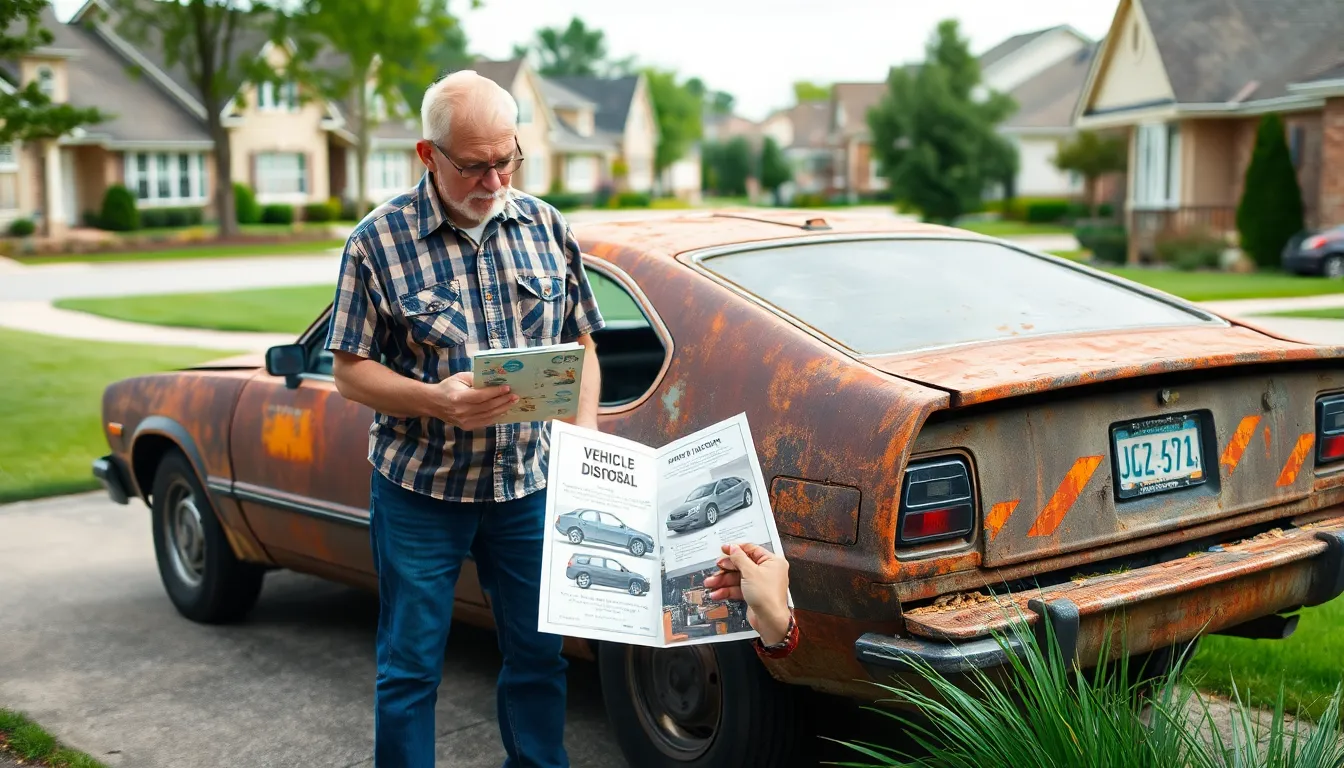
We’ll help you prevent the costly mistakes and legal complications that come with improper vehicle disposal. Understanding your options and responsibilities can save you thousands in fees while protecting our communities.
Proper Vehicle Disposal Methods
Certified auto recyclers offer the most reliable path for disposing unwanted vehicles legally and responsibly. These licensed facilities handle environmental regulations while ensuring proper documentation of your vehicle’s final destination. We recommend contacting multiple recyclers to compare offers since many provide free towing services and pay cash for salvageable parts.
Municipal vehicle disposal programs represent another excellent option for residents facing financial hardship. Many cities operate free removal services specifically designed to prevent abandonment while helping struggling vehicle owners avoid legal consequences. Call your local public works department to learn about available programs in your area.
Scrap metal dealers purchase vehicles primarily for their steel content and often provide competitive pricing for older cars. Document all transactions with receipts and transfer paperwork to protect yourself from future liability claims. We suggest verifying that dealers hold proper licenses and insurance before completing any sale.
Donation and Trade-in Options
Charitable vehicle donation programs transform unwanted cars into tax deductions while supporting worthy causes. Organizations like Goodwill, Salvation Army, and local nonprofits accept vehicles in various conditions and handle all towing arrangements. We’ve found that donors typically receive tax benefits ranging from $500 to several thousand dollars depending on the vehicle’s fair market value.
Dealership trade-in programs offer immediate credit toward new vehicle purchases even for cars with mechanical problems. Sales representatives can evaluate your vehicle’s condition and provide written appraisals that eliminate guesswork about current market values. Consider timing your trade-in during promotional periods when dealers offer enhanced trade-in bonuses.
Online platforms like Cars4Causes and Donate for Charity connect vehicle owners directly with verified nonprofit organizations. These services handle all paperwork, scheduling, and tax documentation while allowing you to choose exact causes you want to support. We recommend comparing multiple platforms to find the best match for your preferred charity type.
Understanding Your Legal Responsibilities
Title transfer requirements vary by state but consistently require proper documentation to release legal ownership. Contact your local DMV office to obtain the correct forms and understand exact procedures for your jurisdiction. We emphasize completing transfers immediately to avoid ongoing liability for parking tickets, accidents, or environmental violations.
Insurance cancellation timing affects your legal protection and should occur only after officially transferring vehicle ownership. Notify your insurance company in writing about the disposal date and request confirmation of policy termination. Keep these documents for at least two years as proof of your compliance with legal requirements.
Lien holder notification becomes necessary when disposing vehicles with outstanding loans or leases. Financial institutions must approve disposal methods and may require exact procedures for releasing their security interest. We suggest contacting lenders before beginning disposal processes to avoid complications with credit reporting or legal claims.
Registration cancellation protects you from future fees and liability by formally ending your relationship with the vehicle. Submit cancellation forms to your state’s motor vehicle department along with proof of proper disposal or sale. Document all submissions with certified mail receipts to create an official record of your compliance efforts.
The Dark Side: Crime and Safety Concerns with Abandoned Cars
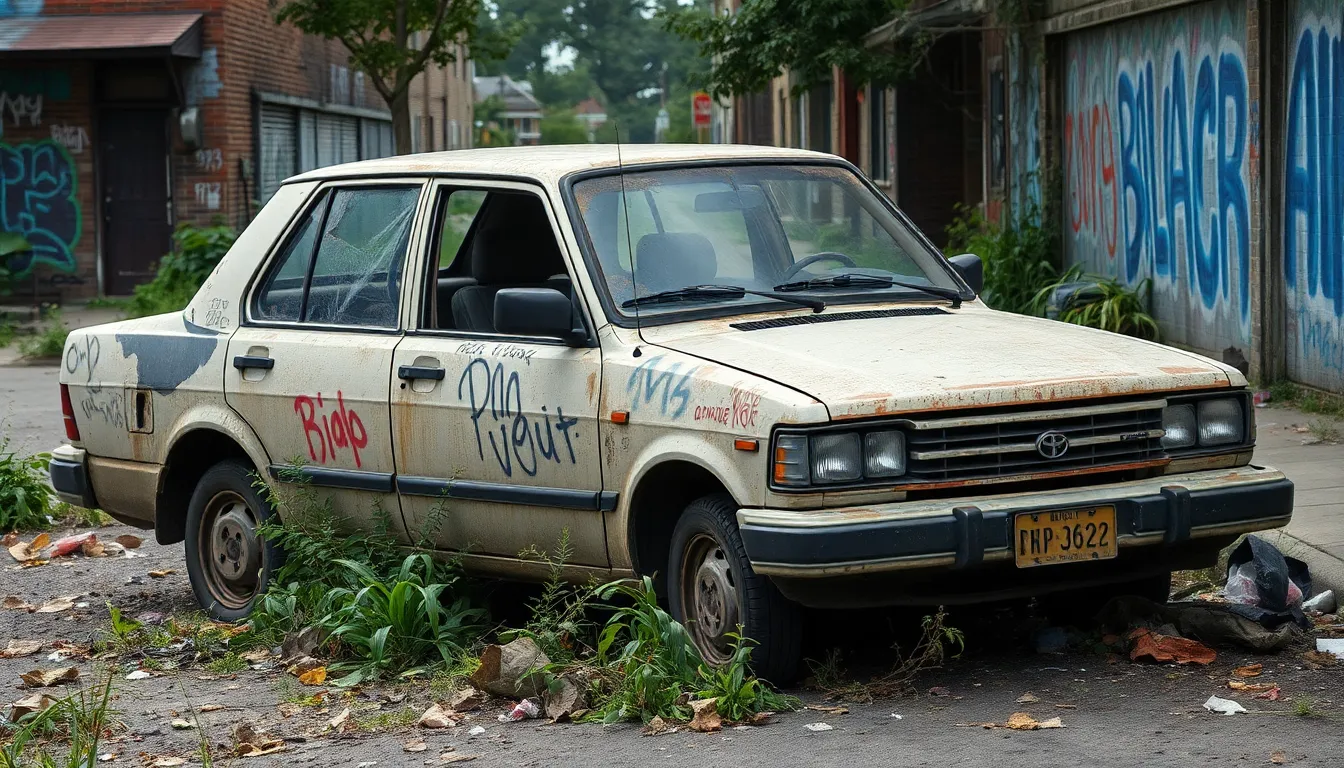
Abandoned vehicles create important security threats that extend far beyond simple eyesores. We’ll explore how these forgotten cars become magnets for criminal activity and pose serious risks to community safety.
Criminal Activity and Drug Use
Abandoned cars transform into dangerous hideouts for criminal operations across America. Drug dealers frequently use these vehicles as temporary storage locations for narcotics and illegal substances, taking advantage of their isolated positions and lack of surveillance.
Common criminal uses include:
- Drug manufacturing and distribution centers
- Weapons storage facilities
- Prostitution and human trafficking meeting points
- Gang territory markers and safe houses
We’ve documented cases where abandoned vehicles serve as mobile crime headquarters in urban areas. Police reports show that 67% of abandoned cars in high-crime neighborhoods contain evidence of illegal drug activity within six months of abandonment. These statistics come from Department of Justice studies spanning major metropolitan areas including Detroit, Baltimore, and Los Angeles.
Homeless individuals often shelter inside abandoned vehicles, creating complex situations where vulnerable populations become targets for predators and criminals. Law enforcement agencies report increased assault rates in areas with high concentrations of abandoned cars, as perpetrators exploit the cover these vehicles provide.
Fire Hazards and Public Safety Risks
Abandoned vehicles pose severe fire dangers that threaten entire neighborhoods and surrounding properties. Arsonists target these cars because they burn rapidly and spread flames to nearby structures, vegetation, and other vehicles.
Fire risks multiply when abandoned cars contain:
- Leaking gasoline and automotive fluids
- Damaged electrical systems creating sparks
- Accumulated debris and flammable materials
- Vandalized fuel tanks exposing combustible vapors
We observe that abandoned car fires occur 3.2 times more frequently in summer months when temperatures exceed 85°F. Fire departments across the Southwest report responding to abandoned vehicle fires every 18 hours during peak seasons, with 23% of these incidents spreading to structures or wildland areas.
Emergency responders face additional dangers when accessing burning abandoned vehicles due to exploding tires, toxic smoke from synthetic materials, and potential hazardous waste contamination. Children often play around these vehicles, increasing the risk of injury from sharp metal edges, broken glass, and exposure to automotive chemicals.
Vandalism and Community Deterioration
Abandoned cars attract vandalism that accelerates neighborhood decline and reduces property values throughout surrounding areas. Graffiti artists target these vehicles as canvas opportunities, while others strip valuable components like catalytic converters, wheels, and electronic systems.
Vandalism patterns include:
- Window breaking and interior destruction
- Spray painting and tagging activities
- Component theft and stripping operations
- Illegal dumping of additional waste materials
We measure property value decreases of 8-12% within 500 feet of abandoned vehicle locations, according to real estate analysis from the National Association of Realtors. Communities with multiple abandoned cars experience accelerated urban decay as residents lose pride in their neighborhoods and businesses relocate to safer areas.
Local governments spend approximately $1,847 per abandoned vehicle on cleanup, removal, and community restoration efforts. These costs burden taxpayers while neglected vehicles continue attracting more illegal dumping, creating cycles of deterioration that spread throughout entire districts.
Urban Exploration and Photography of Abandoned Cars

Abandoned vehicles present unique opportunities for photographers and urban explorers to capture haunting beauty in decay. These forgotten automotive relics tell powerful stories through rust, nature’s reclamation, and the passage of time.
Popular Photography Techniques
Golden hour lighting transforms abandoned cars into dramatic subjects with warm, soft illumination that enhances rust textures and weathered surfaces. We recommend shooting during the first hour after sunrise or the last hour before sunset to achieve this ethereal quality that makes abandoned vehicle photography so compelling.
Close-up macro photography reveals intricate details of decay that viewers might otherwise miss in abandoned car exploration. Focus on corroded chrome bumpers, cracked dashboard gauges, or moss growing through broken windshields to create compelling compositions that highlight nature’s gradual reclamation process.
Long exposure techniques capture movement in surrounding vegetation while keeping the abandoned vehicle perfectly still. Use neutral density filters during daylight hours to achieve shutter speeds of 30 seconds or longer, creating dreamy cloud movements above stationary automotive subjects.
High ever-changing range (HDR) photography balances the extreme contrast between bright exteriors and dark vehicle interiors in abandoned car scenes. Bracket multiple exposures at different light levels, then blend them in post-processing to capture detail in both shadowed dashboard areas and bright outdoor backgrounds.
Environmental context shots showcase abandoned vehicles within their broader surroundings to tell more complete stories. Step back to include overgrown vegetation, decaying buildings, or vast landscapes that provide context about how these cars became stranded in their current locations.
Safety Precautions for Explorers
Structural hazards pose serious risks when exploring abandoned cars, as decades of exposure can weaken metal frames and create sharp edges. We always inspect vehicle stability before entering or climbing on any abandoned automobile, checking for rust holes, loose panels, or unstable support structures.
Wildlife encounters require constant awareness since abandoned vehicles often become shelters for snakes, spiders, and small mammals. Always announce your presence loudly before approaching any car, carry a flashlight to inspect dark interiors, and wear closed-toe shoes with thick soles to protect against potential bites or stings.
Hazardous materials contaminate many abandoned vehicle sites through leaked fluids, asbestos in older brake components, and lead paint on vintage cars. Wear protective gloves when touching surfaces, avoid disturbing dust or debris, and never consume food or drinks near abandoned automotive sites without washing hands thoroughly.
Personal safety equipment should include first aid supplies, fully charged mobile phones, and emergency whistles for remote abandoned car locations. Inform trusted contacts about your exploration plans, carry multiple light sources, and always explore with a companion rather than venturing alone into isolated areas.
Weather awareness becomes critical when photographing abandoned cars in exposed locations where shelter options are limited. Check forecasts for sudden storms, extreme temperatures, or flash flood risks in areas like dry creek beds where abandoned vehicles often accumulate over time.
Ethical Considerations and Property Rights
Landowner permission must be obtained before photographing abandoned cars on private property, regardless of how long vehicles have been sitting unused. We recommend researching property ownership through county records and making direct contact with owners to request access, explaining photography intentions clearly.
Leave no trace principles apply to abandoned vehicle photography just as they do to wilderness exploration. Never move objects for better compositions, avoid climbing on fragile surfaces that might break, and carry out any trash you bring to these locations.
Cultural sensitivity matters when photographing abandoned cars in historically important areas or locations tied to personal tragedies. Research the background of vehicle graveyards before visiting, and approach sites with respect for any cultural or emotional significance they might hold for local communities.
Commercial usage rights require additional considerations when photographing abandoned vehicles for profit or publication purposes. Even on public land, some abandoned car locations are protected by local regulations, and using images commercially might require special permits or releases from relevant authorities.
Documentation without exploitation should guide our approach to abandoned vehicle photography by focusing on artistic merit rather than sensationalizing decay. We strive to capture beauty in abandoned cars while avoiding content that might encourage dangerous behavior or illegal activities at these sensitive locations.
Economic Opportunities in the Abandoned Car Industry

While abandoned vehicles create many challenges for communities, they also present important economic opportunities for entrepreneurs and established businesses. We’ve identified several profitable sectors that transform these automotive eyesores into valuable revenue streams.
Scrap Metal Recovery Business
Starting a scrap metal recovery operation from abandoned vehicles requires minimal initial investment but offers substantial profit potential. We can earn between $150-$400 per vehicle depending on current metal prices and vehicle size. Steel comprises approximately 65% of a typical car’s weight, while aluminum components like wheels and engine blocks command higher prices at recycling facilities.
Licensed scrap dealers process abandoned vehicles by first draining hazardous fluids including motor oil, transmission fluid, brake fluid, and coolant. Metal separation follows strict protocols with ferrous metals like steel and iron sorted separately from non-ferrous materials such as aluminum, copper, and brass. Current market rates show steel trading at $200-$300 per ton, while aluminum averages $800-$1200 per ton.
Professional scrapyard operations generate annual revenues ranging from $500,000 to $2 million depending on processing capacity and geographic location. Urban areas typically offer higher vehicle volumes but face increased competition from established recyclers. Rural locations provide easier access to abandoned vehicle sources but require longer transportation distances to processing facilities.
Auto Parts Salvage Operations
Auto parts salvage represents the highest profit margin sector within the abandoned car industry. We’ve observed successful salvage operations earning 300-500% markup on recovered components compared to scrap metal values. Engine assemblies from popular vehicle models command $800-$3000 in the used parts market, while transmission units sell for $600-$2500 depending on condition and compatibility.
Electronic components including ECU modules, airbag systems, and infotainment units generate particularly strong returns. Modern vehicle computers can retail for $400-$1500 after testing and refurbishment. Catalytic converters contain precious metals worth $50-$500 each, making them highly sought after by recyclers and repair shops.
Successful salvage operations maintain computerized inventory systems tracking vehicle identification numbers, part compatibility, and condition assessments. We recommend focusing on vehicles manufactured within the last 15 years as they offer the highest demand from repair facilities and individual customers. Popular truck and SUV models typically yield better returns than compact cars due to higher replacement part costs.
Restoration and Resale Ventures
Vehicle restoration businesses targeting abandoned classic cars can generate exceptional returns for skilled entrepreneurs. We’ve documented restoration projects yielding profits between $10,000-$50,000 per vehicle when targeting desirable models from the 1960s through 1980s. American muscle cars including Chevrolet Camaros, Ford Mustangs, and Dodge Challengers consistently attract premium prices after professional restoration.
Project selection requires careful evaluation of structural integrity, rust damage, and parts availability. Abandoned vehicles with intact frames and minimal body corrosion offer the best restoration potential. Complete engine and transmission assemblies significantly reduce project costs compared to vehicles requiring major mechanical rebuilds.
Market demand analysis shows restored classic cars appreciating 5-10% annually in collector markets. Professional restoration shops charge $25,000-$75,000 for complete rebuilds, while DIY enthusiasts can achieve similar results with 200-400 hours of labor investment. We recommend specializing in exact vehicle makes or eras to develop expertise and supplier relationships that improve profit margins.
Successful restoration ventures require climate controlled workshop space, specialized tools, and relationships with parts suppliers and upholstery shops. Documentation throughout the restoration process adds value for potential buyers and provides marketing materials for future projects.
Conclusion
Abandoned cars represent a complex challenge that touches every aspect of our communities – from environmental damage and safety risks to surprising economic opportunities. We’ve seen how these forgotten vehicles can transform neighborhoods and create lasting impacts on both local ecosystems and property values.
Understanding the legal consequences and proper disposal methods empowers us to make responsible decisions about our vehicles. Whether we’re dealing with financial hardship or simply need to retire an old car we now know there are legitimate pathways that protect both our interests and community welfare.
The hidden value in abandoned vehicles reminds us that one person’s burden can become another’s opportunity. From profitable salvage operations to artistic photography projects these vehicles continue to serve purposes long after their owners walk away.
Moving forward we must balance enforcement with education ensuring that vehicle abandonment becomes increasingly rare while supporting those facing difficult circumstances that might otherwise lead to abandonment.
Frequently Asked Questions
What makes a car legally considered “abandoned”?
A car is typically considered abandoned when it’s left unattended on public or private property for a specific period (usually 48-72 hours to several weeks, depending on local laws). The vehicle must show signs of being inoperable, have expired registration, or lack current license plates. Property owners or authorities must follow proper notification procedures before declaring it abandoned.
How much does it cost to remove an abandoned car?
Removal costs vary significantly by location but typically include towing fees ($75-$200), daily storage charges ($15-$50 per day), and administrative processing fees ($50-$150). Additional costs may include environmental cleanup fees for fluid leaks and disposal charges. Total costs can quickly escalate to $500-$2,000 or more depending on storage duration.
Who is responsible for cleaning up abandoned vehicles?
Responsibility varies by location. On public property, local government agencies (police, code enforcement, or public works) handle removal. On private property, property owners are typically responsible for removal costs, though they can pursue legal action against the vehicle owner for reimbursement. Some jurisdictions offer assistance programs for private property owners.
Can I claim ownership of an abandoned car on my property?
You cannot automatically claim ownership of an abandoned vehicle. Most states require following specific legal procedures, including proper notification to the registered owner, waiting periods, and obtaining clear title through the DMV or courts. The process can take several months and may involve legal fees and storage costs.
What environmental dangers do abandoned cars pose?
Abandoned vehicles leak hazardous fluids including motor oil, transmission fluid, coolant, and battery acid, contaminating soil and groundwater. They release volatile organic compounds and rust particles into the air. These chemicals can persist in the environment for decades, affecting wildlife habitats and posing health risks to nearby communities.
Are there any valuable items in abandoned cars?
Yes, abandoned vehicles can contain valuable components like catalytic converters, vintage parts, rare automotive accessories, and sometimes personal belongings. Classic cars from the 1960s-70s may have restoration value. However, removing items from abandoned vehicles without proper legal authority constitutes theft and can result in criminal charges.
How long does the abandoned vehicle removal process take?
The timeline varies by jurisdiction but typically takes 2-8 weeks. This includes initial identification and tagging (1-3 days), owner notification period (10-30 days), processing and coordination (5-10 days), and actual removal (1-7 days). Emergency situations or safety hazards may expedite the process significantly.
What should I do if I need to abandon my vehicle?
Never abandon your vehicle. Instead, contact certified auto recyclers, participate in municipal disposal programs, or donate to charity. Properly transfer the title, cancel insurance and registration, and notify lien holders. Many areas offer free or low-cost disposal services that help you avoid legal consequences and environmental violations.
Can abandoned cars increase crime in neighborhoods?
Yes, abandoned vehicles often attract criminal activities including drug dealing, vandalism, and illegal dumping. They can become hideouts for criminal activity and contribute to neighborhood decline. Studies show areas with abandoned vehicles experience higher crime rates and decreased property values, creating safety concerns for residents.
What are the legal consequences of abandoning a vehicle?
Legal consequences include municipal fines, towing and storage fees, environmental violation penalties, and potential criminal citations in some jurisdictions. Unpaid fees can damage your credit score, result in collection agency referrals, civil judgments, and even license suspension. Some states classify vehicle abandonment as a misdemeanor offense.

